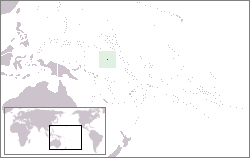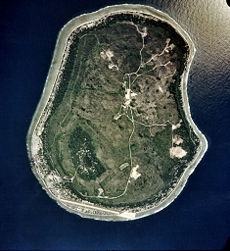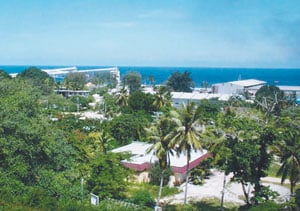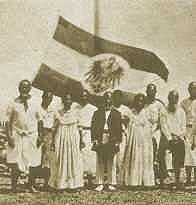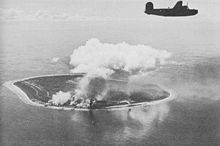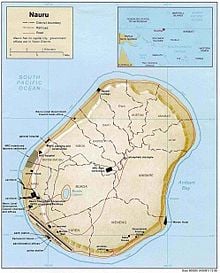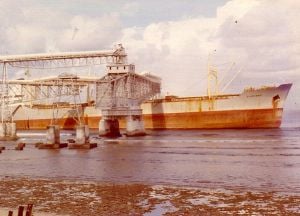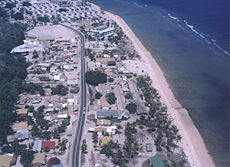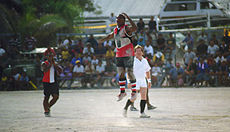Nauru
| Ripublikee Naoero Republic of Nauru |
||||||
|---|---|---|---|---|---|---|
|
||||||
| Motto: "God's Will shall be First" | ||||||
| Anthem: Nauru Bwiema ("Song of Nauru") |
||||||
| Capital | Yaren (de facto)[a] | |||||
| Official languages | English, Nauruan | |||||
| Demonym | Nauruan | |||||
| Government | Republic | |||||
|  -  | President | Sprent Dabwido | ||||
| Independence | ||||||
|  -  | from the Australian, New Zealand, and British-administered U.N. trusteeship. | 31 January 1968  | ||||
| Area | ||||||
|  -  | Total | 21 km² (239th) 8.1 sq mi  |
||||
|  -  | Water (%) | 0.57 | ||||
| Population | ||||||
|  -  | July 2010 estimate | 9,322 [1] (216th) | ||||
|  -  | December 2006 census | 9,275  | ||||
|  -  | Density | 441/km² (23rd) 1,233.3/sq mi |
||||
| GDP (PPP) | 2006 estimate | |||||
|  -  | Total | $36.9 million[2] (192nd) | ||||
| ¬†-¬† | Per capita | $2,500 ('06 est.)[2] ‚Äď $5,000('05 est.)[1]¬†(135th‚Äď141st) | ||||
| Currency | Usually the Australian dollar (AUD) |
|||||
| Time zone | (UTC+12) | |||||
| Internet TLD | .nr | |||||
| Calling code | ++674 | |||||
| a. ^  Nauru does not have an official capital, but Yaren is the largest settlement and the seat of Parliament. | ||||||
Nauru (pronounced ‚Äúnow-roo‚ÄĚ), officially the Republic of Nauru, is a small, oval-shaped island in the western Pacific Ocean, 26 miles (42 kilometers) south of the equator. Nauru is the world's smallest island nation, covering just 21 square kilometers (8.1 square miles), the smallest independent republic, and the only republic in the world without an official capital.
Nauru is a phosphate rock island, and its primary economic activity since 1907 has been the export of phosphate mined from the island. With the exhaustion of phosphate reserves, its environment severely degraded by mining, and the trust established to manage the island's wealth significantly reduced in value, in the 1990s Nauru briefly became a tax haven and money-laundering center to obtain income. Since 2001, in exchange aid from the Australian government, Nauru housed a detention center for asylum seekers trying to enter Australia.
Geography
Nauru is positioned in the Nauru Basin of the Pacific Ocean. From about 35 million years ago, a submarine volcano built up over a hotspot, and formed a 14,100-foot high (4300 meter) basalt seamount. The volcano was eroded to sea level and a coral atoll grew on top to a thickness of about 1,640 feet (500 meters). Coral near the surface has been dated from five million years ago. Magnesium from sea water dolomitised the original limestone. The coral was raised above sea level about 100 feet (30 meters), and is now a dolomite limestone outcrop eroded in classic karst style into pinnacles up to 65 feet (20 meters) high. The limestone has been dissolved forming cavities, sinkholes, and caves to a depth of 180 feet (55 meters) below sea level. Holes on the topside of the island were filled up by a phosphate layer up to ten feet, or several meters, thick.
The island is surrounded by a coral reef, exposed at low tide and dotted with pinnacles. The reef, bound seaward by deep water, and inside by a sandy beach, has prevented building a seaport, although 16 canals cut through the reef allow small boats access. Coral cliffs surround the central plateau, known as Topside. The highest point of the plateau is 213 feet (65 meters) above sea level.
The nearest neighbor is Banaba Island in the Republic of Kiribati, 185 miles (300 kilometers) due east. Nauru's land area is 8.1 square miles (21 square kilometers) with 18.6 miles (30 kilometers) of coastline. Nauru claims a 200 nautical mile (370 kilometers) exclusive fishing zone, and 12 nautical mile (22 kilometers) of territorial waters.
Nauru's climate is hot and extremely humid year-round, because of its proximity to the equator. Monsoon rains, between November and February, bring variable annual rainfall that is influenced by the El Ni√Īo-Southern Oscillation. Droughts have been recorded. The temperature ranges between 79 and 95¬†¬įF (26 and 35¬†¬įC) during the day and between 77 and 82¬†¬įF (25 and 28¬†¬įC) at night.
There are limited natural fresh water resources on Nauru; the island has no rivers or substantial lakes. Roof tanks collect rainwater, but islanders are mostly dependent on a single, aging desalination plant.
There are only 60 plant species native to the island, none of which is widespread. Coconut farming, mining, and introduced species have disturbed the native vegetation. There are no native land mammals, but there are native birds, including the Nauru Reed Warbler, insects, and land crabs. The Polynesian rat, cats, dogs, pigs, and chickens have been introduced.
The narrow coastal belt, where coconut palms flourish, is the only fertile area. Bananas, pineapples, vegetables, pandanus trees, and indigenous hardwoods, such as the tomano tree, are cultivated on the land surrounding Buada Lagoon. The population of about 13,000 is concentrated in the coastal belt and around Buada Lagoon.
Nauru's only natural resources are phosphates, formed from guano deposits by seabirds over many thousands of years. Nauru was one of three great phosphate rock islands in the Pacific Ocean (the others are Banaba (Ocean Island) in Kiribati and Makatea in French Polynesia). But the phosphate reserves are nearly depleted, and mining in the central plateau has left a barren terrain of jagged limestone pinnacles up to 49 feet (15 meters) high. A century of mining has devastated four-fifths of the land area, and has harmed the surrounding exclusive economic zone with 40 percent of marine life killed by silt and phosphate run-off.
Although Nauru does not have an official capital city, it is common for Yaren to be cited as such.
History
Micronesian and Polynesian peoples settled Nauru at least three thousand years ago. There were traditionally 12 clans or tribes. The Nauruan people called their island "Naoero"; the word "Nauru" was later created from "Naoero" for English language speakers. Naurans subsisted on coconut and Pandanus fruit, and caught juvenile milkfish, acclimatized them to fresh water and raised them in Buada Lagoon. Only men were permitted to fish on the reef, and did so from canoes or by using trained man-of-war hawks.
British whaler John Fearn became the first Westerner to visit Nauru in 1798, and named it Pleasant Island. From the 1830s, Nauruans had contact with whaling ships and traders who replenished their supplies at the island. Beachcombers and deserters began to live on the island. The islanders traded food for alcoholic palm wine, known as toddy, and firearms. The firearms were used during the ten-year Nauruan Tribal War that began in 1878 in a dispute at a wedding celebration when a handgun was fired and a young chief was inadvertently killed. The drunken, mindless fighting reduced the population from 1,400 to nine hundred persons.
Germany annexed the island on April 16, 1888, arrested the surviving chiefs, and banned both alcohol and firearms, thus ending the tribal war. The island was incorporated into Germany's Marshall Islands Protectorate, and named Nawodo or Onawero. The war had established kings as rulers, the most widely-known being King Auweyida.
A Catholic missionary and a Congregational minister from the Gilbert Islands arrived in 1888. Those two denominations continue to be popular today.
New Zealand prospector Albert Ellis discovered phosphate there on Nauru in 1900. The Pacific Phosphate Company started to exploit the reserves in 1906 by agreement with Germany, and exported their first shipment in 1907. Following the outbreak of World War I, Australian forces captured the island in 1914. After the war, the League of Nations gave the United Kingdom a trustee mandate over the territory, shared with Australia and New Zealand in 1923. A Nauru Island Agreement, signed in 1919, had created the British Phosphate Commission, which took over the rights to phosphate mining.
During World War II Japan occupied Nauru from August 1942. The Japanese-built airfield on the island was bombed in March 1943, preventing food supplies from reaching the island. The Japanese deported 1,200 Nauruans to work as laborers in the Chuuk islands, where 463 died. Those left on Nauru suffered starvation and bombing by the Americans for two years, before liberation on September 13, 1945, when Japanese forces surrendered to the Australian warship HMAS Diamantina. Nauruans returned from Chuuk on the phosphate ship Trienza in January 1946. By then, the island was a mass of military litter, almost totally lacking in food supplies.
In 1947 a trusteeship was approved by the United Nations, and Australia, New Zealand and the United Kingdom administered the island. Nauru became self-governing in January 1966, and following a two-year constitutional convention, became independent in 1968, led by founding president Hammer DeRoburt. In 1967 the people of Nauru bought the assets of the British Phosphate Commission, and in June 1970, control passed to the locally owned Nauru Phosphate Corporation. Income from the exploitation of phosphate gave Nauruans one of the highest living standards in the Pacific.
In 1989 the country took Australia to the International Court of Justice over Australia's failure to remedy environmental damage caused by phosphate mining. The action led to a sizeable out-of-court settlement to rehabilitate the mined-out areas. Diminishing phosphate reserves led to economic decline, accompanied by increasing political instability; Nauru had 17 changes of administration between 1989 and 2003. Between 1999 and 2003, a series of no-confidence votes and elections resulted in René Harris and Bernard Dowiyogo leading the country for alternating periods. Dowiyogo died in office in March 2003 and Ludwig Scotty was elected president. Scotty was re-elected to serve a full term in October 2004.
Since 2001, a significant proportion of the country's income has come in the form of aid from Australia. In 2001 the MV Tampa, a ship which rescued 460 refugees (from various countries including Afghanistan) from a stranded 65 foot (20 meter) boat that was seeking to dock in Australia, was diverted to Nauru, and the refugees housed in a detention center. Nauru continued to operate the detention center in exchange for Australian aid. However, as of November 2005, only two asylum seekers remained on Nauru.
Politics
Nauru is a republic with a parliamentary system of government. The president is both the head of state and head of government. An 18-member unicameral Parliament is elected every three years. Parliament elects a president from its members, who then appoints a cabinet of five to six persons from among sitting Parliament members. Candidates typically stand as independents. Alliances within the government are often formed on the basis of extended family ties. Three active parties are the Democratic Party of Nauru, Nauru First, and the (Nauru) Center Party.
Since 1992, local government has been the responsibility of the Nauru Island Council, which has limited powers and advises the national government. Nauru is divided into 14 administrative districts that are grouped into eight electoral constituencies.
All Nauruans have certain rights to all land, which is owned by individuals and family groups. Government and corporate entities do not own land and must lease from the landowners. Non-Nauruans cannot own land.
The Supreme Court, headed by the chief justice, is paramount on constitutional issues. Other cases can be appealed to the two-judge Appellate Court. Parliament cannot overturn court decisions, but Appellate Court rulings can be appealed to the High Court of Australia, which rarely happens. Lower courts consist of the District Court and the Family Court, both of which are headed by a resident magistrate, who also is the Registrar of the Supreme Court. Finally, there also are two quasi-courts: the Public Service Appeal Board and the Police Appeal Board, both of which are presided over by the chief justice. Defense is the responsibility of Australia. There is a small police force under civilian control.
The national day, Angam Day, held on October 26 each year, celebrates the recovery of the Nauran population after the two world wars, both of which reduced the indigenous population to fewer than 1,500. Independence Day is celebrated January 31.
Nauru has used its position as a member of the United Nations to gain financial support from both Taiwan and the People's Republic of China by changing its position advantageously on the political status of Taiwan.
Economy
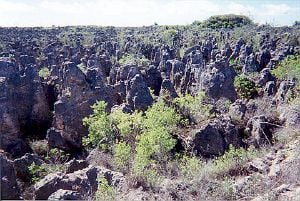
Nauru's economy depends on declining phosphate deposits. Most necessities are imported. Small-scale mining is still conducted by the Nauru Phosphate Commission. The government places a percentage of the commission's earnings in the Nauru Phosphate Royalties Trust. The trust manages long-term investments.
However, a history of bad investments, financial mismanagement, overspending, and corruption has reduced the trust's fixed and current assets. Nauru House in Melbourne, Australia, was sold in 2004 to pay debts and Air Nauru's last Boeing 737 was repossessed in December 2005. The value of the trust is estimated to have shrunk from AU$1.3 billion in 1991 to AU$138 million in 2002. By the early twenty-first century, Nauru lacked money to perform many of the basic functions of government, the national Bank of Nauru was insolvent, and GDP per capita had fallen to US$5,000 per annum.
There are no personal taxes in Nauru, and the government employs 95 percent of those Nauruans who work. Unemployment is estimated at 90 percent.
The Asian Development Bank noted that without an alternative to phosphate mining, dependence on aid will continue. The sale of deep-sea fishing rights may generate some revenue. Tourism is not a major contributor to the economy. In the 1990s, Nauru became a tax haven and offered passports to foreign nationals for a fee. It became a favorite spot for the dirty money of the Russian mafia until pressure from the inter-governmental Financial Action Task Force on Money Laundering stopped it.
Exports totaled US$64,000 in 2005, the sole commodity being phosphate, to South Africa (56.4 percent), India (15.3 percent), South Korea (6.7 percent), and Canada (5.8 percent).
Imports of food, fuel, manufactures, building materials, machinery, from South Korea (43.4 percent), Australia (35.8 percent), the United States (5.9 percent), and Germany (4.3 percent) totaled US$20 million in 2004. With and external debt of US$33.3 million, Nauru receives economic aid from Australia.
Nauru uses the Australian dollar as its official currency.
Demographics
Nauruans are descended from Polynesian and Micronesian seafarers. Two of the 12 original tribal groups had disappeared in the twentieth century. Of the island's 13,287 residents (July 2006 estimate), 58 percent are Nauruan, 26 percent other Pacific Islanders, 8 percent Chinese, and 8 percent Europeans.
A higher standard of living since independence has accelerated obesity. Besides rice and fish, which contributes to a high rate of obesity, traditional Nauruan cuisine is nearly nonexistent, as western ‚Äújunk food‚ÄĚ has prevailed. Nauruans are among the most obese people in the world, with 90 percent of adults overweight. More than 40 percent of the population has type-II diabetes, the world's highest rate. Other diet-related problems include renal failure and heart disease. Life expectancy has fallen to 58 years for males and 65 years for females.
The Nauruan indigenous religion is a monotheistic system of belief that includes a female deity called Eijebong and an island of spirits called Buitani. Believers say that a spider called Areop-Enap created the sky and the earth. However, the prevailing religion is Christianity. The Congregational Church is the national church. Two-thirds of the population is Congregationalist, and one-third is Roman Catholic. The Catholic Church provides a secondary school. The Nauruan Constitution provides for freedom of religion, but the government has placed restrictions on members of the Church of Jesus Christ of Latter-day Saints and Jehovah's Witnesses, most of whom are foreign workers employed by the Nauru Phosphate Corporation.
The official language is Nauruan (or dorerin Naoero), a distinctive Pacific Island language of the Micronesian family of the Austronesian language group. There was a diversity of dialects until Philip Delaporte published his pocket German-Nauruan dictionary in 1907. In 1938 there was an attempt by the Nauruan language committee to make the language easier to understand for Europeans and Americans. About half of the population speaks Nauruan. English is the language of government and commerce.
A matrilineal social system gives women power. Therefore, women lead behind the scenes, while men take the political roles in government. However, more women have taken jobs in the civil service over the past 20 years. Most primary school teachers are women, while men are active in phosphate management.
National identity as Nauruan remains strong, and can be claimed only by those born of a Nauruan mother. Failure to register a child at birth as Nauruan eliminates that person from the entitlements, particularly land rights and shares in phosphate revenue. A child of a Nauruan father, but whose mother is of another nationality must seek special permission to be registered as Nauruan.
Nauruans are proudly democratic and denounce the two classes that formerly marked their society. The temonibe and amenengame classes consisted of the senior matrilineage as opposed to those in the junior matrilineages. These two classes were further distinguished from the itsio, or slave class, which included those who arrived on Nauru from outside and had no land holdings. Heads of lineages were drawn from the temonibe class. A chiefly system instituted in 1927 was replaced in 1951 by the Nauru Local Government Council that consists of elected members.
Culture
Literacy on the island is 97 percent, education is compulsory for children from six to 15 years of age (years one‚Äďten), and two non-compulsory years are taught (years 11 and 12). There is a campus of the University of the South Pacific on the island. Before the campus was built, students traveled to Australia for their university education.
Colonial and contemporary western culture has largely replaced indigenous culture. Some traditional music and arts and crafts remain, and some traditional methods of fishing are still practiced. For example, island anglers wait in small light boats for fish to arrive. A traditional activity is catching noddy (tern) birds when they return from foraging at sea. The captured noddies are cooked and eaten.
Music and dance still rank among the most popular art forms. Rhythmic singing and traditional reigen are performed particularly at celebrations. Radio Nauru, a state-owned, non-commercial station, has collected numerous recordings of local music. But even old Nauruans can rarely understand the contents of these songs. The Department of Education has produced a history from a Nauruan perspective and a Nauruan dictionary. Writers were encouraged to produce stories, poems, and songs.
Craftsmen make articles of clothing and fans of Kokosfasern and the sheets of the screw tree. They also use geometrical symbols, which resemble those of the Indonesian culture. The Nauruan people wear the usual tropical clothes: short trousers and light shirts.
There is no daily news publication, although there are several weekly or biweekly publications, including the Bulletin, the Central Star News, and The Nauru Chronicle. There is a state-owned television station, Nauru Television (NTV), that broadcasts programs from New Zealand, and Radio Nauru carries items from Radio Australia and the BBC.
Australian rules football is the most popular sport in Nauru. There is an Australian rules football elite national league with seven teams. All games are played at the island's only stadium, Linkbelt Oval. Other sports include softball, cricket, golf, sailing, and soccer. Nauru participates in the Commonwealth Games and Summer Olympic Games, where it has been successful in weightlifting. Marcus Stephen, a prominent medalist, was elected to Parliament in 2003.
Notes
- ‚ÜĎ 1.0 1.1 Error on call to template:cite web: Parameters url and title must be specifiedCentral Intelligence Agency (2011). . The World Factbook.
- ‚ÜĎ 2.0 2.1 Country Economic Report: Nauru. Asian Development Bank. Retrieved November 22, 2011.
ReferencesISBN links support NWE through referral fees
- "Paradise well and truly lost." The Economist. December 20, 2001. Retrieved May 23, 2007. Subscription required.
- Ellis, A. F. 1935. Ocean Island and Nauru - Their Story. Angus and Robertson Limited.
- Garrett, J. 1996. Island Exiles. ABC Books (Australian Broadcasting Corp.) ISBN 0733304850
- Haden, J. D. 2000. ‚ÄúNauru: A Middle Ground in World War II.‚ÄĚ Pacific Magazine. Retrieved May 23, 2007.
- Highet, K. and H. Kahale. 1993. ‚ÄúCertain Phosphate Lands in Nauru.‚ÄĚ The American Journal of International Law 87: 282-288.
- King, H. and M. Rewers. 1993. ‚ÄúDiabetes in adults is now a Third World problem.‚ÄĚ World Health Organization Ad Hoc Diabetes Reporting Group. Ethnicity & Disease 3: 67-74.
- McDaniel, C. N. and J. M. Gowdy. 2000. Paradise for Sale. Berkeley, CA: University of California Press. ISBN 0520222296
- U.S. Department of State. Nauru (04/07) Retrieved May 23, 2007.
External links
All links retrieved November 11, 2022.
| Countries and territories of Oceania | |
| Australia : Australia · Norfolk Island | |
| Melanesia : East Timor · Fiji · Maluku Islands & Western New Guinea (part of Indonesia) · New Caledonia · Papua New Guinea · Solomon Islands · Vanuatu | |
| Micronesia : Guam · Kiribati · Marshall Islands · Northern Mariana Islands · Federated States of Micronesia · Nauru · Palau · Wake Island | |
| Polynesia : American Samoa · Cook Islands · French Polynesia · Hawaii · New Zealand · Niue · Pitcairn Islands · Samoa · Tokelau · Tonga · Tuvalu · Wallis and Futuna | |
Credits
New World Encyclopedia writers and editors rewrote and completed the Wikipedia article in accordance with New World Encyclopedia standards. This article abides by terms of the Creative Commons CC-by-sa 3.0 License (CC-by-sa), which may be used and disseminated with proper attribution. Credit is due under the terms of this license that can reference both the New World Encyclopedia contributors and the selfless volunteer contributors of the Wikimedia Foundation. To cite this article click here for a list of acceptable citing formats.The history of earlier contributions by wikipedians is accessible to researchers here:
The history of this article since it was imported to New World Encyclopedia:
Note: Some restrictions may apply to use of individual images which are separately licensed.


